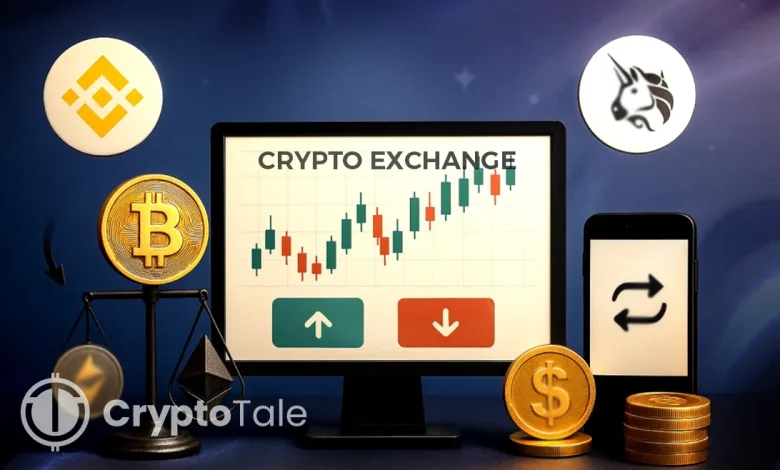The Evolution of Crypto Exchanges: From Forums to Super Apps

Cryptocurrency exchanges have transformed from basic peer-to-peer trading platforms into sophisticated “super apps,” playing a key role in the global financial landscape. As of 2025, these exchanges manage trillions of dollars in transactions and are integrated with a wide variety of services, including trading, payments, lending, and tokenization.
New adoption data revealed in a recent State of Crypto 2025 report quantifies the gap between holders and on-chain users. Analysts at a16z estimate that there are 40–70 million monthly active users, while approximately 716 million people worldwide own crypto, representing a 16% increase from last year.
These figures frame why exchanges now matter to daily finance as much as to trading. The adoption highlights increasing use of mobile wallets and stronger institutional infrastructure, which help crypto exchanges develop into super apps that make everyday activities smoother.
From Trading Venues to Super Apps
These crypto exchanges are becoming multi-service “super apps” that enable trading, payments, and holding, as well as accessing on-chain services. Due to major policy shifts, cheaper Layer-2 fees, and live tokenization and stablecoin pilot programs, the shift gained momentum.
The concept of a crypto super app draws inspiration from platforms like WeChat and Alipay in China.
A super app is an app that combines multiple services in a single interface, such as payments, chats, investments, and other functionalities, thereby establishing a well-balanced ecosystem.
Cryptocurrency exchanges are increasingly adopting this model to evolve into comprehensive financial hubs rather than merely niche trading websites. This enables users to fulfill most of their daily needs with one application.
Binance: Maintains dominance through its ecosystem, which includes Binance Pay for payments, a launchpad for new tokens, Binance Earn for staking, and partnerships for services like ride-hailing and food delivery.
Coinbase has evolved beyond its exchange roots with its Base app, which integrates a self-custody wallet, social networking features, and payments, positioning itself as a “bank replacement.”
MEXC: As a hybrid centralized/decentralized exchange, MEXC has expanded into Web3, offering a wide array of listed assets and futures trading.
BingX: Focuses on social trading and AI integration, which includes AI-powered trading insights and tools for copy trading.
Plena: Offers a crypto super app with a self-custodial wallet that features simplified trading, asset bridging, and a “crypto chat and pay” function.
Moreover, competition is growing as more platforms adopt super-app strategies. The super-app race is not limited to cryptocurrency, as it represents a broader merger between financial services and technology.
Walmart’s OnePay now offers crypto trading within its fintech app, used by millions, contributing to the expanding adoption of crypto by retailers.
Bolt launched a super app that integrates crypto trading, digital banking, peer-to-peer transfers, and commerce, with the goal of becoming a “financial operating system for the modern” user consumer.
Western Union plans to deliver stablecoins directly to recipients in under‑banked regions, demonstrating the appeal of crypto payments for remittances.
Fintech firms like PayPal and Robinhood have added high‑yield savings accounts, tax services, and bill payments to their apps.
Brokers such as XTB offer currency exchange and payment cards.
The mainstream adoption is likely to be pushed by stablecoin payments. Examples of services such as OKX Pay and PayFi, offered by Bitget, demonstrate how QR codes can be used to transfer funds instantly and at low costs. These networks also minimize the use of banks and credit card programs, especially in areas where high remittance fees are charged. With the development of better cross-border rails, more people might start using crypto wallets to engage in daily operations.
In addition, Institutional investors may find tokenized assets attractive, as they are interested in liquidity and 24-hour trading. Regulatory approval and investor protection are key to determining the success of real-world asset tokens. Exchanges could capture a larger share of the traditional markets if regulators clarify how tokenized stocks and bonds are treated.
Innovative Features: Stablecoins, DeFi, and Tokenization
Cryptocurrency exchanges have introduced a range of products beyond spot trading. A key element is a stablecoin, which provides an interface between digital assets and fiat currency. Dollar-backed tokens, such as USDT or USDC, can be traded on both centralized and decentralized exchanges, allowing users to store value without being vulnerable to fluctuations. Their use also drives payment networks, and experts have demonstrated that QR-code systems enable users to pay with USDT or USDC, like in Vietnam and Brazil.
Moreover, decentralized finance has pushed exchanges to include staking, lending, and yield products. Centralized platforms are poised to provide users with access to liquidity pools and automated market makers by integrating DeFi protocols into their existing infrastructure, while handling custody and compliance.
Hybrid models also enable users to earn yields on their assets without having to exit the crypto exchange. Such a combination of CeFi and DeFi capabilities underscores the shift toward universal platforms.
Tokenization of real‑world assets is another significant innovation. Exchanges partner with issuers to list tokenized stocks, bond funds, and money‑market instruments. These digital tokens represent fractional ownership of traditional assets and can be traded 24/7.
An example of this is the collaboration between Bitget, xStocks, and Ondo, where users can purchase tokenized shares and corporate bonds.
The roadmap includes plans for tokenized gold, foreign exchange, and private credit. Tokenization expands the investable universe and may attract investors who prefer regulated, asset‑backed tokens.
Furthermore, crypto exchanges have introduced the use of AI tools that analyze market data to generate trading signals. Multiple platforms offer market intelligence tools that identify early-stage tokens with powerful on-chain indicators. These features are beneficial for both professional traders and retail investors. With increasing competition, platforms vary in educational content, portfolio analysis, and personalized recommendations.
Related: What Is Inner Circle Trader (ICT) Strategy? The Complete Guide
The first crypto exchange, BitcoinMarket.com, was launched in 2010. The platform enabled its users to exchange PayPal balances with Bitcoin and provided the earliest quoted price of the new asset. Prior to this, trading occurred on forums where buyers and sellers had to negotiate with each other privately. The introduction of an order book by BitcoinMarket demonstrated that digital assets might get the attention of a wider audience and provide a transparent price reference.
The Rise And Fall of Mt. Gox
Soon after the launch of BitcoinMarket, programmer Jed McCaleb repurposed his Magic: The Gathering cards site into the infamous Mt. Gox Bitcoin exchange, which at one time was the largest Bitcoin exchange in the world.
Mt. Gox quickly dominated the majority of the market; by 2013 and 2014, it processed more than 70 percent of all bitcoin transactions. The 2014 failure, which resulted in a loss of approximately 850,000 BTC due to its inability to maintain centralized custody and poor corporate governance, highlighted flaws in security, governance, and regulation, necessitating improvements in crypto exchanges.
Emergence of Alternative
Early platforms relied on centralized custody and order books. They handled fiat deposits, matched orders, and managed liquidity withdrawals. In addition, exchanges used to store users’ private keys, which introduced single points of failure vulnerable to hacking.
Related: Private Key Vs Seed Phrase: What You Need to Know
Several exchanges, including Bitcoinica and Bitfloor, were compromised, resulting in the loss of millions of dollars. Nevertheless, the failures led to innovations. Developers rolled out the use of multi-signature wallets and the allocation of cold storage. Exchanges also began to apply for licenses as money-service businesses, providing the basis for regulation.
The event triggered a new era of exchanges, including Coinbase, Kraken, and Bitstamp. That emphasized cold storage, multi-factor authentication, internal controls, more transparent disclosures, user protection, and compliance.
Key Milestones and Technological Advancements
Pivotal events can characterize the progress of crypto exchanges. In 2011, alternative cryptocurrencies, such as Litecoin, expanded the number of trading options beyond Bitcoin. In 2013, when Bitcoin reached $1,000, a wave of exchanges catering to retailers was triggered by the bull market.
However, the boom in initial coin offerings (ICOs) of 2017 was what brought exchanges to a new level.
Related: What Is an ICO? Understanding Initial Coin Offerings in 2025
Introduced in the same year, Binance rose to prominence through its extensive token listings and low fees. Its fast expansion showed the demand for flexible platforms that could list new assets within a shorter period.
Meanwhile, other exchanges sought to align with regulatory standards. Coinbase was established in 2012 and specializes in compliance and user experience, becoming the first large cryptocurrency company to be publicly traded.
The institutional interest boom of the 2020 bull run led to the introduction of derivatives, staking, and lending products, transforming exchanges into full-fledged financial markets. The regulators’ response was in the form of capital reserve requirements, anti-money laundering rules, and Know Your Customer (KYC) checks. These steps formed the basis of additional innovation.
One of the most significant developments was the introduction of decentralized exchanges (DEXs), such as Uniswap, in 2018.
DEXs rely on automated market makers and smart contracts to facilitate peer-to-peer swaps without the need for intermediaries. Users control their wallets and trade directly on the blockchain.
This model gained recognition during the DeFi boom of 2020-2021, which showcased features like transparency, permissionless access, and continuous liquidity. However, other problems with DEXs include higher slippage, fragmented liquidity, and reliance on network fees.
The development of hybrid exchanges (HEXs) erased the boundary between centralized and decentralized models. Such platforms combine both order-book performance and on-chain settlement.
Final Words
In the near future, the leading exchanges will include built-in wallets, on-chain swaps, and staking capabilities. Scaling solutions, including Layer 2 networks, minimized transaction fees, and DeFi, became more accessible. The development of simple markets into multi-asset hubs has paved the way for modern super apps.




